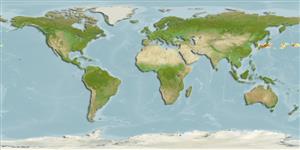Holocephali (Chimären, Seekatzen) (chimaeras) >
Chimaeriformes (Chimaeras) >
Chimaeridae (Shortnose chimaeras or ratfishes)
Etymology: Chimaera: Named for the mythological creature composed of parts of multiple animals, referring to their odd mix of characteristics. (See ETYFish); owstoni: In honor of Alan Owston (1853‒1915), English businessman, yachtsman, and collector of Asian wildlife, who supplied holotype. (See ETYFish).
More on author: Tanaka.
Environment: milieu / climate zone / depth range / distribution range
Ökologie
seewasser bathydemersal. Deep-water
Northwest Pacific: Sagami Bay, Japan.
Size / Gewicht / Alter
Maturity: Lm ? range ? - ? cm
Oviparous (Ref. 205). Eggs are encased in horny shells (Ref. 205).
Life cycle and mating behavior
Maturities | Fortpflanzung | Spawnings | Egg(s) | Fecundities | Larven
Masuda, H., K. Amaoka, C. Araga, T. Uyeno and T. Yoshino, 1984. The fishes of the Japanese Archipelago. Vol. 1. Tokai University Press, Tokyo, Japan. 437 p. (text). (Ref. 559)
IUCN Rote Liste Status (Ref. 130435)
Bedrohung für Menschen
Harmless
Nutzung durch Menschen
Tools
Zusatzinformationen
Download XML
Internet Quellen
Estimates based on models
Preferred temperature (Ref.
123201): 0.2 - 4, mean 2.5 °C (based on 50 cells).
Phylogenetic diversity index (Ref.
82804): PD
50 = 0.5000 [Uniqueness, from 0.5 = low to 2.0 = high].
Bayesian length-weight: a=0.00282 (0.00118 - 0.00673), b=3.10 (2.89 - 3.31), in cm total length, based on LWR estimates for this (Sub)family-body shape (Ref.
93245).
Trophic level (Ref.
69278): 3.7 ±0.6 se; based on size and trophs of closest relatives
Widerstandsfähigkeit (Ref.
120179): niedrig, Verdopplung der Population dauert 4,5 - 14 Jahre. (Assuming Fec <100).
Fishing Vulnerability (Ref.
59153): High vulnerability (57 of 100).
